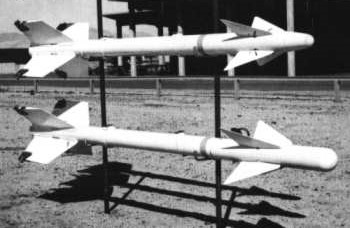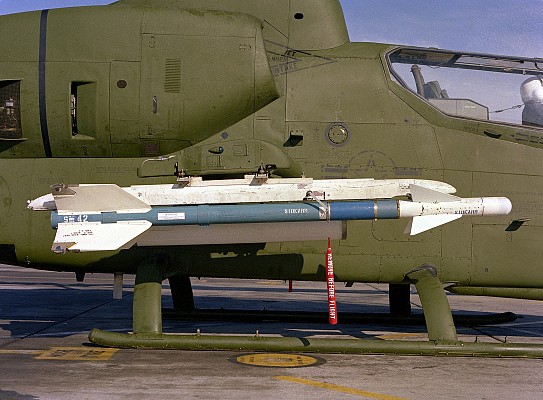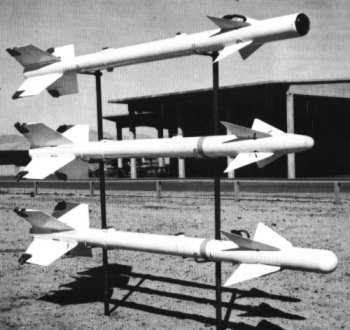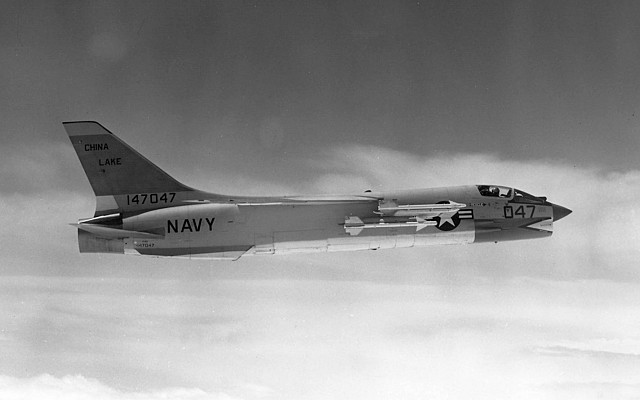AIM-9C Sidewinder
AAM-N-7 Sidewinder IC (SARH)
Overview

AIM-9C Sidewinder
Both missiles of the Sidewinder IC development program. The infrared guided AIM-9D is seen on top and the SARH guided AIM-9C is seen below.
Source: www.designation-systems.info -
© Copyright lies with original owner
AIM-9C (1963 rename)
Description
Introduction
The AIM-9C Sidewinder is an early Cold War era short range air to air missile of American origin. The AIM-9C was developed as one of the two missiles making up the Sidewinder IC program. AIM-9C is unique in having a SARH guidance system. The counterpart is the AIM-9D with its infrared homing guidance system, as do all other variants in the Sidewinder family of missiles. The Sidewinder IC was short lived in US service. The idea of having seeker options for the same missile body proved unsuccessful in US service, but lasted for many decades in various Soviet designs.
Design
The AIM-9C and AIM-9D are both part of the Sidewinder IC development. These missiles are identical except for the guidance section. The Sidewinder IC introduced the more capable Hercules MK 36 rocket motor that provides for a longer range and increased air speed. The AIM-9C is identified by its longer and less tapered nose section compared to the AIM-9D.
Guidance
The AIM-9C is the only version of the Sidewinder to use semi-active radar homing. All other variants use infrared homing. Semi-active radar requires radar illumination of the target. This provides the AIM-9C with all weather capability, which was not yet present in early model infrared guided Sidewinder missiles. the SARH guidance probably allowed for all aspect engagement, or at least to a certain degree against non maneuvering targets. In practice the AIM-9C proved unsuccessful, partly due to reliability issues of the radar on the F-8 Crusader.
Firepower
The new rocket motor allowed both models of the Sidewinder IC with a speed of Mach 2.5 and maximum range of 18 km. Compared to the older AIM-9B the warhead has doubled in size and is now a continuous rod instead of fragmentation. That the AIM-9C proved unsuccessful was mostly due to the limited accuracy and chance to hit. Maneuvering targets reportedly resulted in the missile losing track of the target or incapable of correcting for the target maneuvers. Also the contact fuse requires a direct hit.
Platforms
The Vought F-8 Crusader was the only aircraft to ever be equipped with the AIM-9C. The F-8 Crusader is a carrier based air superiority fighter. The AIM-9C was adopted alongside the infrared homing AIM-9D to provide an all weather capability, without having to modify the radar in the Crusader to be compatible with the larger AIM-7 Sparrow.
Users
The sole user of the AIM-9C was the US Navy. Only about a thousand of these missiles have been produced. The majority of these missiles were converted to AGM-122 Sidearm in the mid to late 1980's, which is a compact anti-radiation missile. Whereas the United States stopped the pursuit of a radar homing variant of the Sidewinder, the Soviet Union introduced the rather similar R-3R missile in 1967 for use on the MiG-21 and MiG-23 fighter aircraft.
Details
Media
Related articles

AGM-122 Sidearm
The AGM-122A was an anti-radiation missile that was produced by converting existing stocks of AIM-9C. Of the roughly 1.000 AIM-9C produced about 700 were converted to Sidearm for use by the US Marine Corps helicopters and close air support aircraft.



